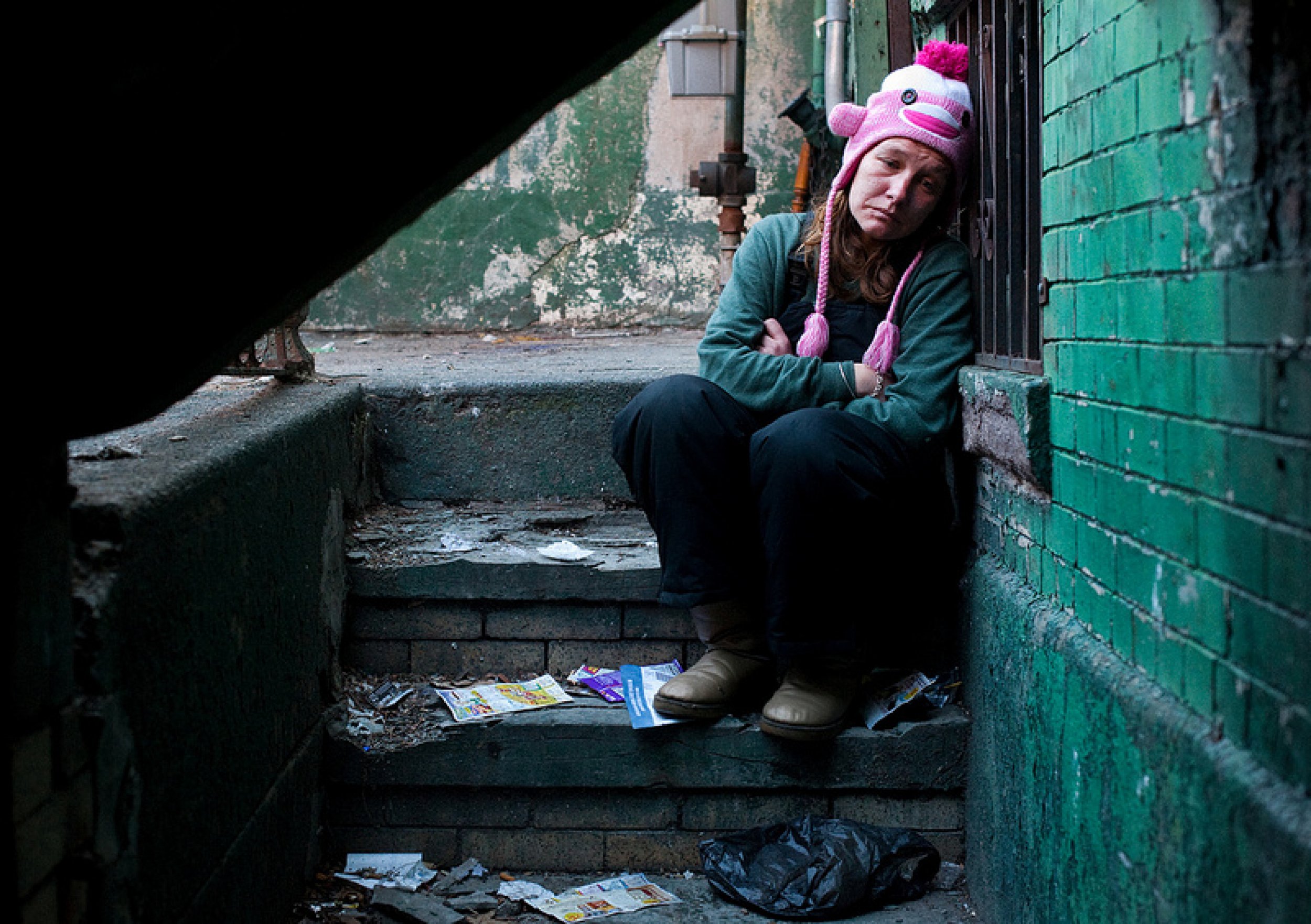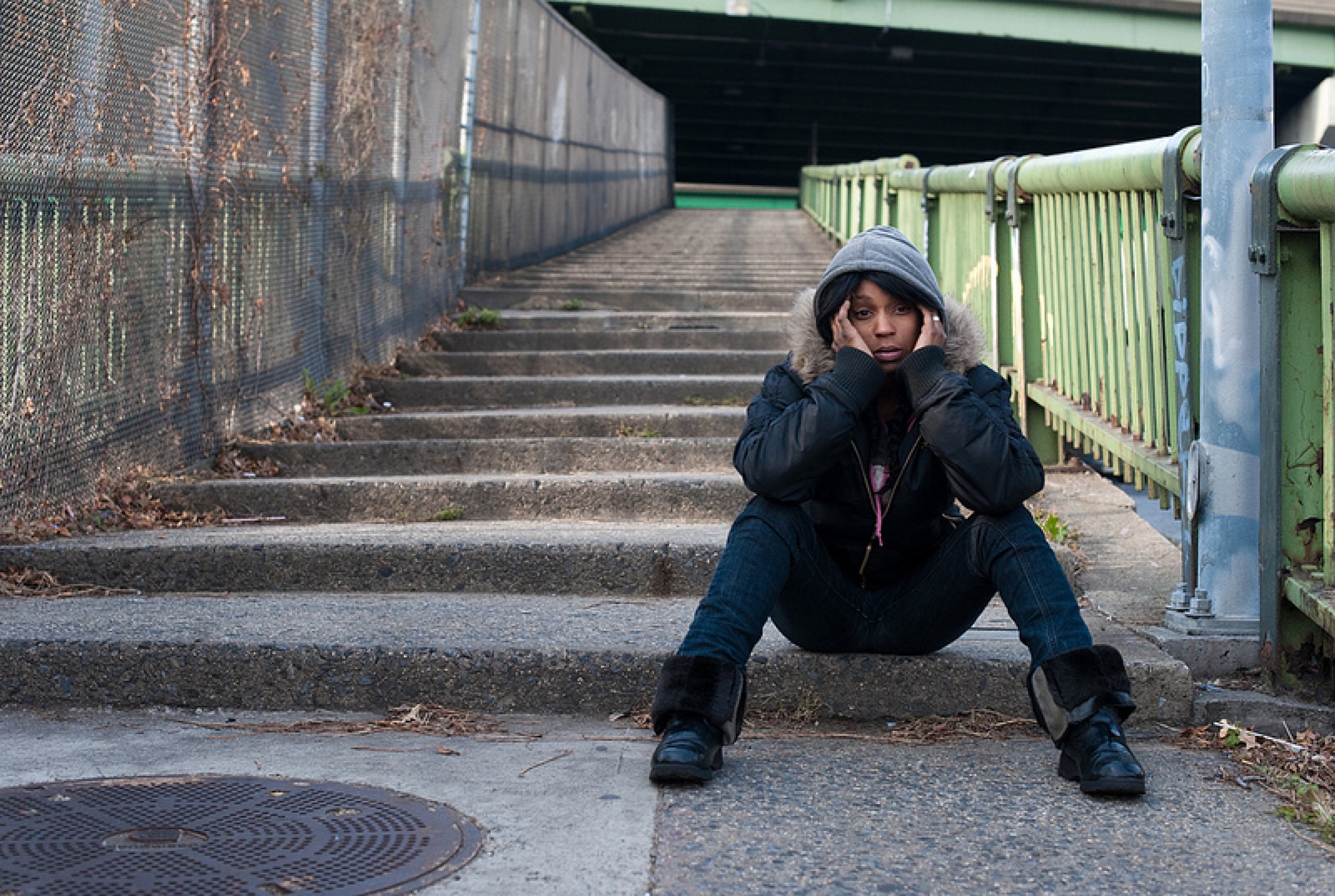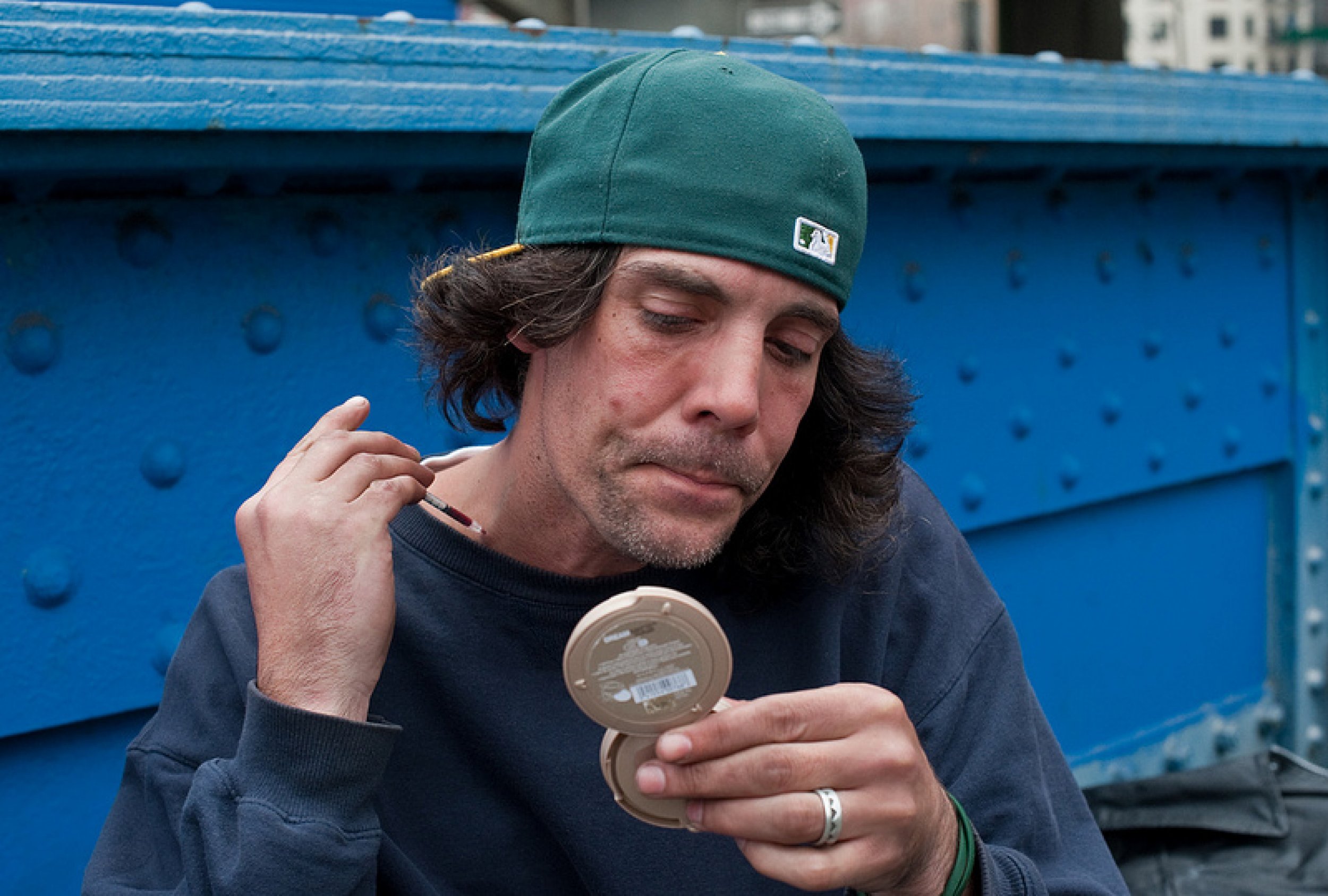Chris Arnade: 'Faces of Addiction' Photographer Discusses Hunts Point Drug Addicts, Underage Prostitutes And Photographing New York [INTERVIEW/SLIDESHOW]
Chris Arnade is a hard man to peg. He has a Ph.D. in physics, was a Wall Street banker for two decades, and is now a writer and a photographer, most famous for his “Faces of Addiction” series on Flickr. In “Faces of Addiction,” Arnade goes to some of the most impoverished neighborhoods in New York City, armed only with a camera. He takes portraits of drug addicts and prostitutes, giving them a voice and letting them tell their story.
Born and raised in San Antonio, near Tampa in Florida, Arnade moved to New York and worked in finance, but photography was always a passion. In an interview, he described how he started on 20-mile treks across the city with his camera, though Greenpoint, Williamsburg, Woodside, Jackson Heights and all the way into Flushing. He would trace a similar path in the opposite direction to Coney Island. A keen observer of the people of New York, he described Queens as a “confederacy of small neighborhoods, of nationalities.” Arnade has photographed some of the most interesting subjects: the Schwinn clubs of Manhattan, pigeon keepers in Bushwick, and the inhabitants of East New York.
With “Faces of Addiction,” shot in the Hunts Point section of the Bronx, it’s become more than a hobby, and Arnade does more than take a picture and move on. Arnade, who regularly updates his Facebook, Flickr and Twitter, discusses how he works and gets close, sometimes uncomfortably close, to his subjects.
IBTimes: In regards to “Faces of Addiction,” have you noticed a change in the trust with the people you are photographing?
Arnade: That’s been 90 percent of the project. Most people, unless you do photography, people who see the pictures don’t understand the bulk of the work comes in building the trust. Especially with the type of photography I’m doing. So yeah, definitely, I get a lot of emails and a lot of requests saying, “Can I come along with you?” or “How do you do it?” You have to put in the effort and time and prove you are somebody who is trustworthy to them and you have to be doing it for the right reasons. If you’re not doing it for the right reasons, they are going to figure it out.
I never want to take a portrait of someone who doesn’t trust me because the picture will reflect that, and to be able to see into the person, you really need to have their trust. Getting that trust took a lot of effort of just going back and going back and going back. In my mind, if there is a trick, if there’s a genuine trick, it’s to show no fear. I’ve never once been scared. I think I’ve written before that it is presumptuous to be scared of someone you’ve never met before; it assumes that they are a certain person who they may not be necessarily. The trust has certainly grown as I’ve spent more time there and there are still a lot of people in the neighborhood.
The neighborhood is literally 99.7 percent Hispanic and black, and I’m obviously neither, and there is certainly a segment of the population that will never ever believe I am anything other than an undercover cop. I can’t do anything about that other than to continue to come back and behave appropriately.
IBTimes: At the start of the “Faces of Addiction” project, there are obviously constraints such as lighting, but did you think of shooting candids instead of portraits?
Arnade: I don’t particularly like candids. I’m moving more towards that just because the series is starting to look, in my eyes, is beginning to look a little bit stale. You can only do so many people looking at the camera, but the entire idea wasn’t something I originally thought out in my head, it just kind of evolved to that.
The original idea was I wanted to take conventional photos of unconventional people. The easy thing that’s been done often in the past is to take kind of “gotcha” pictures. There have been two kinds of things done in the past, one I like and one I don’t like. The one I don’t like is the “gotcha” pictures, which is taking a long lens, standing across the street and using your constitutional right to take a picture of whoever the hell you want to take a picture of, which is fine but not morally correct.
The second one is dragging them into studios, but what I wanted to do was a mixture of both, of something in between, of them in context of where they work, where they live, but taking the time to have them look at the camera, have them lit to a degree that I can light. The idea was to have the viewer look at the subject as a person and then beneath that use that opportunity while they are looking at it to allow the subject to tell their story, in their words.
IBTimes: What about video?
Arnade: I don’t like video. I think one of the things that’s interesting to me is, I’m a photographer. The problem with video is when you watch a video of somebody there is so much going on that you, the viewer, don’t take the time to actually look at the person as a person.
Half of what I do, if not more, is the words underneath the picture. So it’s equally important that while the person is looking at the picture they also use that opportunity to read and I’ve made it intentionally short and most, almost 80 percent, of what I write, is what they’ve ask me to write. I ask them, “What do you want me to say?” The best I can describe, or the best I can remember, the best I can paraphrase, of what they were saying.
The goal is basically, if there is a goal, I was a banker, I live in a nice neighborhood, I know that most people are afforded the opportunity to make a narrative about them that works for them. Some people do it through PR, some people do it through subtle lies or the way they present themselves to others. Often addicts who are homeless are not really given a platform that allows them to say “This is who I am.” Even if it is lying, that’s fine because we all lie, but it’s allowing them to portray themselves, and hopefully that breaks some stereotypes. In the absence of a narrative from them, we put a narrative on them that works for us.
I think society doesn’t particularly want to think that there could be people who have been left behind who are immensely talented that have been left behind for no reason of their own. It’s much easier to move on with the day if you don’t think about that, so it’s easier to say “They’re lazy” or they got their just desserts.
IBTimes: Have you noticed a change in your subjects, be it age or anything of that nature?
Arnade: It’s more of what I’ve had access to. As the project has changed, it’s not necessarily the neighborhood changing as more of what I’ve had access to. I’ve shied away, for a variety of reasons initially, from taking pictures of people under the age of 18. There are a whole bunch of legal issues, not directed at me but directed at them. That becomes a much more complex issue, but at some point I got tired, I didn’t feel it was appropriate to hide certain things from people, to edit that out. So I started to take pictures of the underage prostitutes. Because A) they exist and they are part of the story but B) because people need to know that 15 minutes away from their nice home there’s 14- and 15-year-old girls that are put out on the street.
IBTimes: Have the police been interested in your work? Have they asked you questions?
Arnade: The only thing the police have ever done is hassle me. The police look at it. I’ve met some officers who have said, “Hey, I saw your stuff,” but they jokingly ask me where are these guys, but I can’t tell them. Initially, I got a lot of hassle from the police thinking that I was either a john or buying drugs. I have talked to the lieutenant in charge of the precinct to tell him what I’ve been doing and he’s actually quite helpful. It’s important for me to not ever take a side. I’m there to observe, I’m not there to push things one way or the other.
IBTimes: Do you think New York affords you the ability to work on a project like this?
Arnade: What’s particularly jarring about Hunts Point is that I don’t think many people in New York ever know it exists and obviously its 15 minutes from the Upper East Side, which is one of the wealthiest neighborhoods in the United States, while Hunts Point is one of the five poorest neighborhoods, so the disparity makes the whole thing more jarring.
IBTimes: What other projects have you worked on in New York?
Arnade: I had done some stuff before, the pigeon series. I focused on East New York a little bit, I explored the Bronx more, but right now I think I’m going to focus on the addiction series.
IBTimes: Has your past prepared you for this?
Arnade: My parents both were certainly people who focused their energies on helping the marginalized, whatever term you want to use, people with two strikes against them, human rights, and so I guess I have a natural inclination from my youth to, if I see somebody be treated unjustly or tried unjustly, my natural inclination is to see what’s up, to see if it’s truly unjust and if it is, to do my best to spotlight it. Both my parents worked very actively with civil rights in the South, so there’s a natural inclination in my family to focus on human rights.
IBTimes: Have you been able to keep in touch with people in your series? I’m sure it’s difficult to stay in contact with people you have worked with in Hunts Point.
Arnade: Addicts in Hunts Point are a bit like meteorites -- they come in and they burn bright and then disappear. It’s either they go to jail, they pass away, they get clean, hopefully, and move, they go into rehab, but there has been a group of characters and what I have chosen to do is, since I quit my job, to spend that additional time focusing on parts of their life that are not necessarily conducive to taking pictures like visiting them in jail, seeing them in the hospital, going to court and watching the proceedings. Last week, I drove one of my subjects, Michael, up to meet his mother who he hasn’t seen in four years and spent the night in the town he grew up in.
IBTimes: Do people seek you out?
Arnade: I get a lot of calls these days because I help them out, now and then. I help them out monetarily if it’s really pressing. I would like to think that I’ve developed some friendships. They call me when they are in really tight spots, if they need a ride somewhere or if they need me to look up something on the computer or if they just want to talk. The biggest question I have in my mind right now is, going forward, “Have I gotten too close?” I don’t have a problem with that personally, in terms of the project.
IBTimes: Would that change the focus of the project?
Arnade: It would certainly change it to more writing as well as photography, so I’m shifting my focus to writing, but I’m not a particularly strong writer; it takes a lot of effort. It’s a hard evolution for me, but there is a lot that isn’t seen in the pictures that I think need to be said or is helpful to be heard.





© Copyright IBTimes 2024. All rights reserved.






















